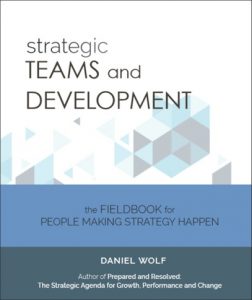Teams and Structure
Strategic Teams and Structure
Teams of one sort or another are part of an organization’s structure. They help bring order and arrangement to the work to be done for decision-making processes, for risk management and problem solving. Teams provide inter-functional depth and cross-functional reach. They provide the capacity for knowledge management and project management. Teams become the adaptive structure for people to operate together as the organization’s agents of making strategy happen. The design and structure of teams is very important at every level of the enterprise.
So far, so good … but structure and organization design can get complex and noisy with teams.
Breaking down the things that are difficult in organizations is one way of looking at how teams function and operate. Communication between and among functions can be messy. Effective leadership within and across spans of teams is sometimes a challenge. Disparities in resources, processes, systems and practices, from team to team and across the enterprise, are common sources of tension. Design for purpose, for Lean, for change, for relationships, for growth, for operational sync and leverage – these are themes that can test the trust, energy, and power of teams, at every level of the organization. And of course, there is culture – and teams are a breeding ground for subcultures and cultural tension.
Getting Things in Order …
In our research for Strategic Teams and Development, these and other challenges were explored as part of the structural view of organizations. The growing dependence on teams fosters some key questions about strategy, talent, and culture:
- What Strategic Roles and Functions are Needed?
This is fundamental. Why do we need this or that team in place? What is their primary work to be done? Who is responsible for how this team or that team contributes to the creation of strategic and economic impact? Start with the Big Why?
- What Kind of Talent is Best Suited for the Team?
This is what starts with the cast and crew. Given the charter for the team, what is the appropriate blend and balance of talent vis-à-vis technical, analytic, creative, resource, solution and relational knack and competence? Who makes this work?
- What Cultural Factors Assure and Secure the Team?
This guides the team’s everyday thought and behavior and informs strategy and process. It also speaks to how the team learns and develops to operate on target, as conditions change. Secure teams function well, and they advance well.
Further, how do teams serve the work of forward planning, decision making, risk management and problem solving? Where do individuals and teams gather the experience, knowledge and resilience to serve when they play different roles, have different power, serve in tight spaces, or work across open horizons? Where does the logic of organization design shape the focus on teams as elements of competitive advantage? Where does the adaptive nature of organization design depend on teams as the laboratory for people making strategy happen, in the good times, and the bad? Who governs all of this strategy integration and execution work?
These are leadership and management questions that live across the Strategic Teams and Development conversation. The formation, cultivation, advancement, and integration of teams is part and parcel of the enterprise structure and design of forward-focused organizations, and the people who make them successful, near-term and long-term. Teams enable strategic progress, and teams provide the framework for what used to be called The Learning Organization. Teams are the new structure, the new “lattice” of competence and collaboration.
The ideas defined above are the subject of our new fieldbook entitled Strategic Teams and Development planned for release at the end of the year. The fieldbook is designed as a resource for individuals and teams at every level of the enterprise. From every angle, Strategic Teams and Development speaks to the ideas that contribute to better, stronger, smarter, faster teams that are focused on results and on making strategy happen, taking care of today and getting ready for tomorrow.
Daniel Wolf is the President of Dewar Sloan, a consulting group with expertise in strategy and governance. He is the author of Strategic Teams and Development — as well as Prepared and Resolved: The Strategic Agenda for Growth, Performance and Change.






Sorry, the comment form is closed at this time.